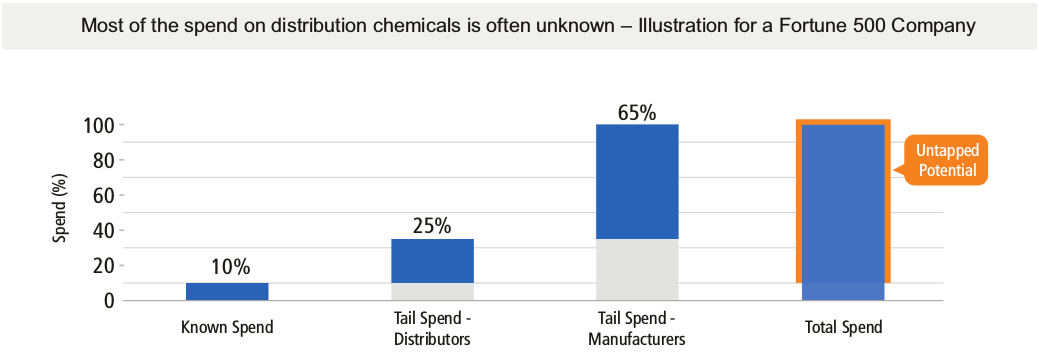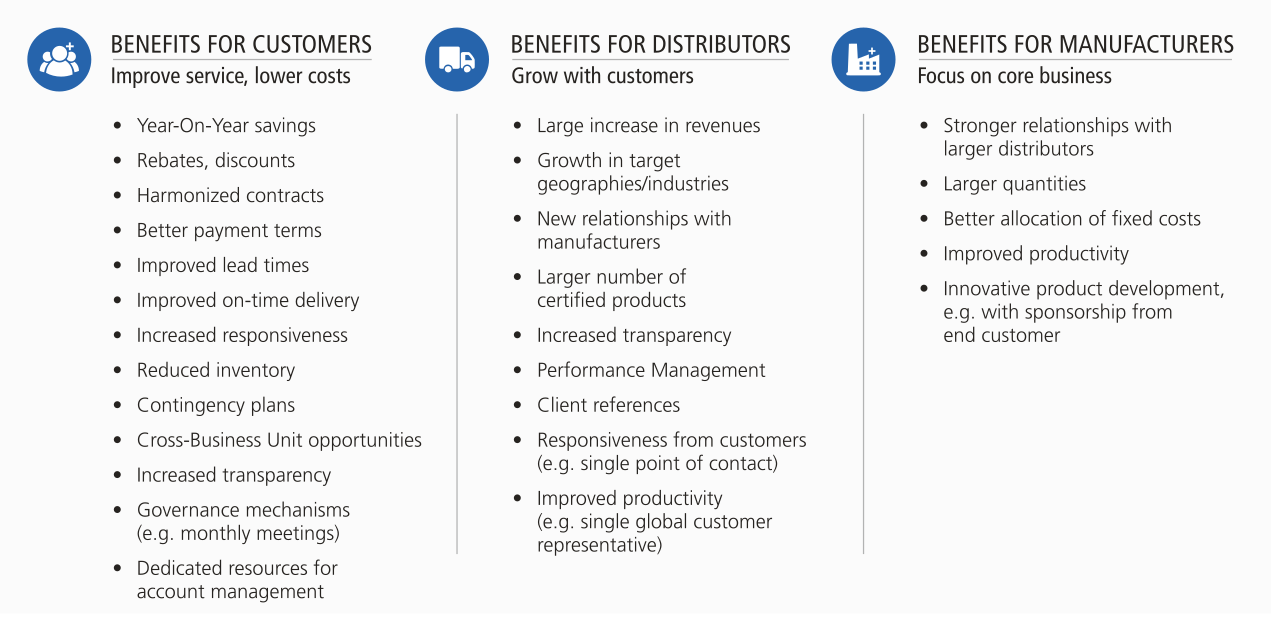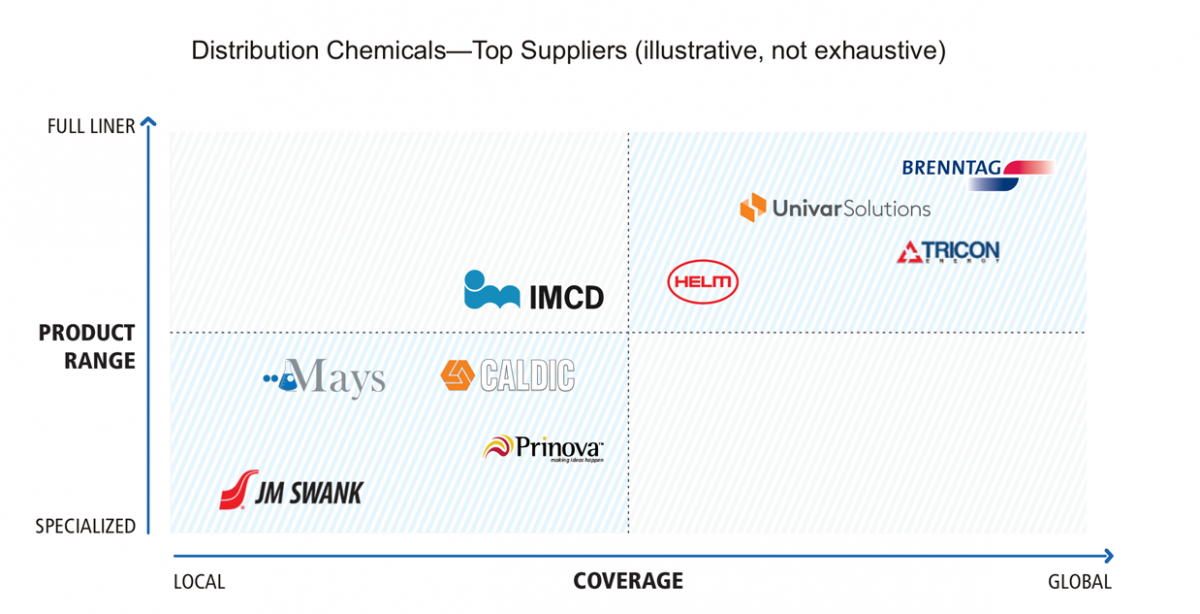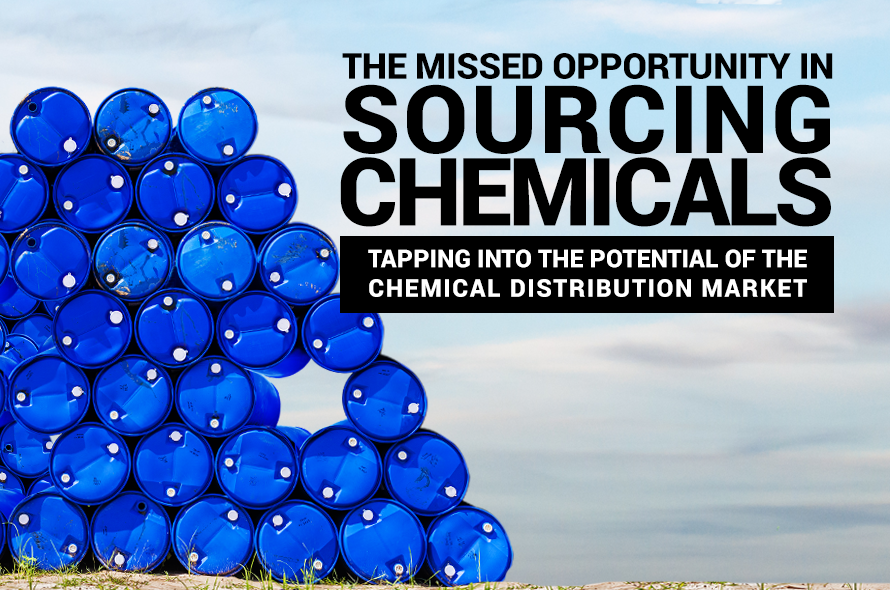Introduction
Within the chemical industry, the role of distributors is evolving in response to changing demand: more companies need better services, specialized products, or precise and typically smaller quantities than in the past, which may not be in the manufacturer's best interests. Distributors can offer tailored quantities along with bespoke products and services that manufacturers cannot always provide. Procurement organizations considering “Distribution Chemicals” as a category in itself, with its own sourcing and category management strategies, can gain a strategic advantage.
Important benefits can be achieved through strong partnerships with distributors, including financial gains, improved customer service and greater governance. However, these opportunities are often left unexploited due to four main issues: a lack of strategic focus and priority, a limited understanding of spend, minimal supplier empowerment and limited internal communications.
Understanding this complex and evolving industry has enabled unprecedented gains for several of our clients. This paper reviews key trends and explains how companies purchasing chemicals can quantify their true distribution chemical spend, surmount the constraints of this market, and develop mutually beneficial partnerships with distributors.
Chemical distribution is a big market with untapped potential
The global chemical market was estimated at $3.95 trillion (€3.5 trillion) in 2017, including $213 billion (€190 billion) of chemical distribution (approximately 5 percent). The top three players, Brenntag, Univar Solutions (formed from the acquisition of Nexeo Solutions in 2019 by Univar Inc.) and Tricon Energy, represent 6.6 percent, 5.1 percent and 3.1 percent respectively; the rest are spread across thousands of suppliers
Experience has shown that our clients often underestimate exactly how much they spend on chemical distribution due to a highly fragmented supplier base. Performing this analysis can reveal a much bigger spend than anticipated because it is split among a lengthy tail of small suppliers. It is therefore important to gain visibility on the total spend. We’ve helped a number of companies improve visibility in this area through advanced analytics.

Known Spend: Spend with chemical distributors, typically with large suppliers
Tail-Spend from Distributors: Spend from smaller chemical distributors, with limited visibility
Tail-Spend from Manufacturers: Chemicals currently bought directly from manufacturers, that might be better procured from distributors
What companies can learn from this:
It can be challenging to have a comprehensive outlook on the distribution chemicals that are purchased, and thus to identify the full amount spent on the category. Companies are often aware of only a fraction of what they spend on distribution chemicals, typically from their largest distributors. A few essential steps to complete a precise category spend profile are:
- Define precisely your scope. Several aspects of the product are to be considered when defining the category. Determine which materials (chemicals, other materials), suppliers (distributors, manufacturers), packaging types (bottles, drums, totes, pails, bulk items etc.), packaging sizes and locations. Start wide, then hone in based on constraints or focus.
- Determine how to quantify your distribution chemical spend. This will likely be necessary to get a complete picture of the spend: use the help of buyers, business unit representatives, on-site quality managers, Enterprise Resource Planning (ERP) systems and other stand-alone databases/spreadsheets, contracts etc. This can be a complicated, iterative and lengthy process. Manage expectations with leadership along the way to avoid shutting down a useful exercise.
- Consider adding small spend from manufacturers and other spend items that could potentially be better served by distributors. Manufacturers sometimes prefer to focus on bigger items and might want to leave small quantities off the table, especially when additional requirements are necessary (e.g. short lead times). This will increase the potential and the visibility of your initiative quite drastically.
Along the way, make sure to mobilize strong resources: the effort of gathering, cleansing and validating the data will require a team of analytical individuals who are also able to bring people and systems together.
A complex category with important constraints
There are important opportunities to be gained from a good understanding of the chemical distribution market, and one has to be aware of its constraints. We see mainly four of them,
- External certifications and regulations: Distributors must comply with ISO certifications and other similar standards, as well as regional regulations such as REACH (Registration, Evaluation, Authorisation and restriction of CHemicals) in the European Union, to transport, store and dispose of chemicals. Buying from a distributor that does not have essential certifications can increase risks and the time required to certify a new product, or an existing product in a new plant.
- Internal qualifications: Within each company, the process of approving new products, or even new suppliers (without a change of product) can be long and tedious. The qualification is typically an individual process for each material and can take several months depending on the urgency (or lack of). Long and complicated internal qualification processes prevent quick wins.
- Partnerships: Partnerships between manufacturers and distributors mean specific products are prioritized. Exclusive relationships add complexity and can prevent quick wins from changing manufacturers (e.g. switching from a branded to a generic product), or distributors (e.g. to consolidate spend).
- Suboptimal/lack of contracts with distributors: Many orders are spot buys, which while achieving at times what may seem as a lower price, can also substantially diminish visibility and prevent the business from maximizing further opportunities. Furthermore, even when contracts are in place, clauses providing discounts or additional services are often overlooked.
What companies can learn from this:
Acknowledging constraints and working around them is essential. A few options are proposed below (in the same order as above):
- Develop an efficient audit process and plan on certifications and regulations to prevent future repercussions, such as revenue loss, reputational damage and supply risk.
- Optimize internal qualification processes to facilitate quick wins. Simplifying them can fast track changes of supplier or product, increase flexibility and long-term gains. A holistic project to optimize these processes across business units and materials will derive unprecedented value to any company that currently certifies each material on an individual basis.
- Propose win-win-win plans for your company (the customer), distributors and manufacturers to overcome rigid relationships between manufacturers and distributors. Below is an illustrative summary of potential benefits:

- Implement and improve contracts with price transparency and uniform payment terms. This will facilitate compliance tracking and competitiveness and provide a solid base for a strong partnership in the long term.
Include frequent benchmarking and Total Cost of Ownership (TCO) analysis with partner agreements to enable price tracking vs. market movements. TCO may include original product costs, warehousing costs, packaging costs, labor costs, fuel costs, and disposal costs. Visibility on all cost components prevents opportunity losses linked to the price decrease of any single cost component. For example, with enough transparency it is easy to verify whether the fall in the oil price is accurately reflected in the overall price evolution.
Effective Positioning, Unprecedented Opportunities
With an increasing demand for distribution chemicals, large distributors may have aggressive growth targets. Buyers should take these into account to establish successful partnerships with distributors. These tend to focus their growth objectives on three dimensions:
- Products: Distributors will have greatest incentives to grow their portfolio of specialized products for growing industries such as food, pharmaceuticals, or personal care.
- Geographies: They may prioritize fast growing regions such as Asia, Latin America and the Middle East.
- Value-Added Services: Distributors can differentiate themselves through unique services and convenience to their customers, such as: labeling, packaging, blending and increasingly inventory management or services similar to Third Party Logistics (3PL) providers.
Distributors also can pursue growth both inorganically and organically.
- Inorganically: Distributors may prioritize acquisitions that reflect the three growth priorities above and target smaller distributors accordingly. Univar’s acquisition of Nexeo Solutions in 2019 is aimed at expanding and strengthening Univar’s presence in North America in addition to broadening its product mix. Brenntag’s acquisition of Petra Industries was aimed to improve its value-added services by providing specialized liquid and dry blending, packaging and terminal services to various chemical industry customers. In the last 5 years,
the market leaders have acquired more than 15 companies. - Organically: By winning strategic customer accounts, distributors have an important growth opportunity. This includes advantages such as capability development in products and/or geographies, referrals, industry influence etc. Organic growth can also bear significantly lower costs than acquisitions.

What companies can learn from this:
- Awareness of your company’s value to distributors is crucial. If by developing a strategic relationship with you, a distributor gets the same benefits as with the acquisition of a small distributor, but at lower costs, then you will achieve greater benefits.
- Distributors will see the greatest strategic value in customers that enable expansion in key markets. The closer the alignment of both parties in their growth strategies, the stronger the basis for win-win partnerships. The table below illustrates how companies and distributors can build partnership.

The potential opportunities for companies vary with their position in the above chart:
- There is scope for the development of a win-win partnership because these companies’ industry positions represent a good opportunity for distributors to increase capabilities and influence in a target industry.
- As this is the best opportunity for distributors, companies in this position will have the greatest room for negotiation in the development of a win-win partnership.
- These companies are the least likely to represent a good partner for a distributor. Since bargaining power is limited, they should adopt a more traditional go-to-market approach for their chemicals.
- There is scope for the development of a win-win partnership because the size of these companies represents a good opportunity for distributors to increase their revenue through consolidation.
Case Study
Customer: A Fortune 500 Global Chemical Company
Challenge: This client had an unknown and very fragmented distribution spend along with unclear qualification processes for each individual material.
Approach: An extensive multidimensional assessment helped bring spend visibility and strategically position our client in front of a shortlist of potential chemical distribution partners. We established the base for solid and mutually beneficial partnerships in which the selected distributors found great growth opportunities.
Benefits: GEP’s holistic approach resulted in unprecedented cost savings, improved contracts and customer service through strong partnerships. In addition, category managers and buyers gained an important understanding of how to tackle the category spend strategically, enabling them to increase productivity in their daily work. This initiative enabled our client’s procurement organization to improve operational efficiency radically across levels, functions and geographies.
Conclusion
As distributors become increasingly aggressive by targeting growth in mature markets and expansion in developing markets, they are creating more opportunities for those looking to source chemicals. With organic growth opportunities less costly than M&A activity for distributors, there is an untapped potential, especially around the development of mutually beneficial partnerships with common growth objectives.
To outline the terms of these potential partnerships, it is essential to have the best understanding of the value your company brings to the table. One key element is to know how much of your chemical spend can be provided by distributors. A thorough analysis can double or even triple the size of what is initially known to be distribution chemical spend, and in an industry where size matters, it can lead to much greater benefits.

